Intraoperative imaging of the proximal forearm
1. Introduction
Fluoroscopic visualization of anatomical fracture reduction and correct implant placement for the proximal forearm can be greatly facilitated using the following views:
- AP view of the proximal forearm
- Lateral view of the elbow
- Oblique view of the proximal forearm
- Axial view of the proximal forearm
- AP view of proximal radio-ulnar joint
The following represents ideal imaging with the patient placed in the supine position. The posture of the arm and forearm remains the same for patients in lateral decubitus and prone positions.
The orientation of the C-arm has to be adjusted accordingly.
2. AP view of the proximal forearm
Positioning for optimal view
- Shoulder is in 90° abduction and neutral rotation
- The elbow is in full extension
- The forearm is in full supination
- The beam is placed perpendicular to the forearm
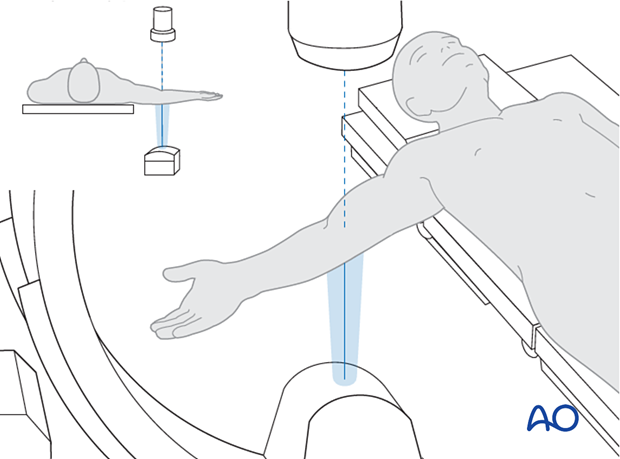
In case the elbow cannot be fully extended (eg 20° flexion) the AP view can be compensated by extending the shoulder as illustrated (eg 20°).
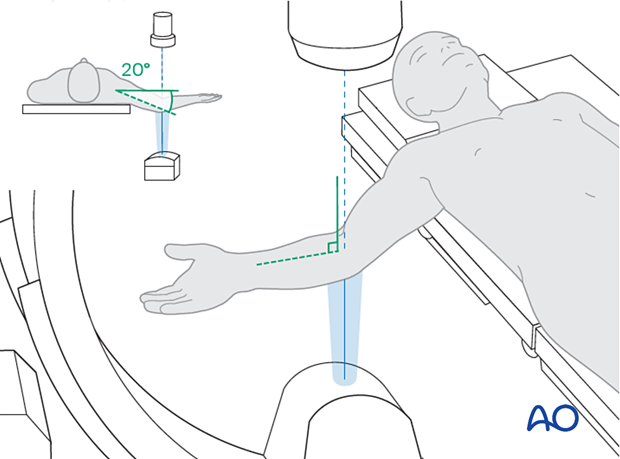
Verification of optimal view
The optimal view is obtained when the:
- ulnohumeral joint lines are congruent
- tip of coronoid is midway between the radial and ulnar borders of the proximal ulna
- anteromedial facet coronoid is visible
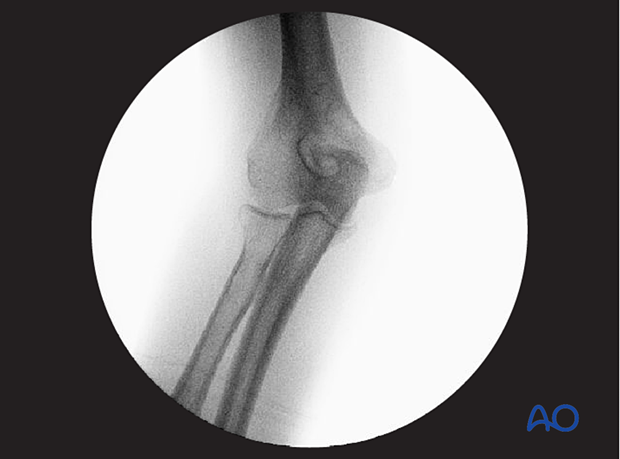
Anatomical landmarks and lines
The following lines and landmarks can be observed:
- Joint line of distal humerus
- Joint line of proximal ulna and radius
- Anteromedial facet of coronoid
- Tip of coronoid (arrow-head)
- Radial border of proximal ulna
- Ulnar border of proximal ulna
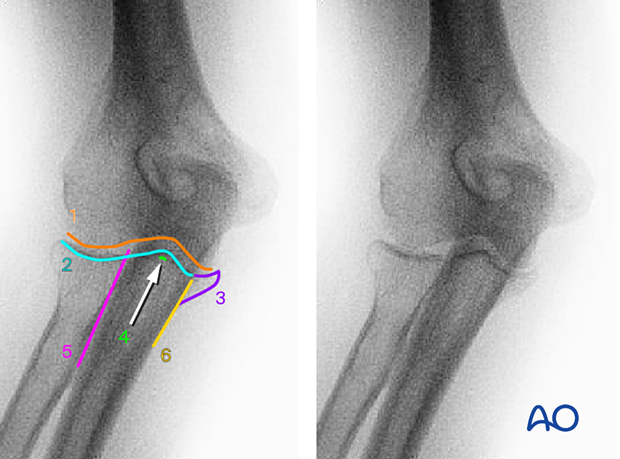
What can be observed
This view is particularly useful to identify:
- fractures and malalignment of ulnohumeral joint, radial head (rotate through pronation and supination range), anteromedial facet and tip of coronoid, and olecranon
- implant malpositioning on the proximal ulna and radial head
3. Lateral view of the elbow
Positioning for optimal view
- Shoulder in 90° abduction and 90° internal or external rotation. (in cases with restricted shoulder motion, the beam can be rotated as needed)
- The elbow is flexed 90°
- The forearm is in neutral rotation
- The beam is placed perpendicular to the humerus and the forearm
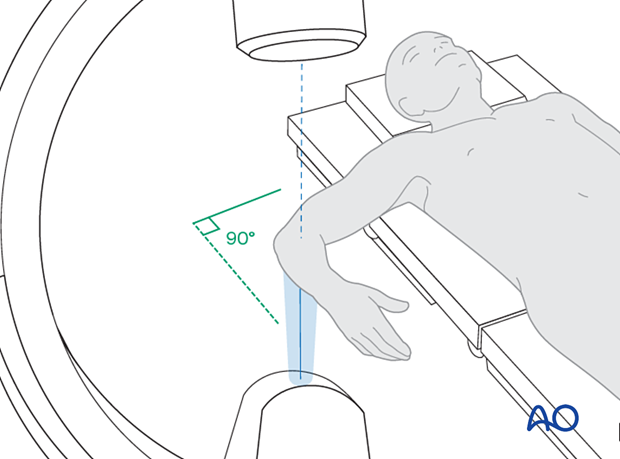
Verification of optimal view
The optimal view is obtained when:
- Ulnoradiohumeral joint space is visible (Note: the joint line between olecranon tip and olecranon fossa cannot be assessed on this view)
- Radial head and coronoid process are aligned
- The axis of the proximal radial shaft is aligned with the center of the capitellum
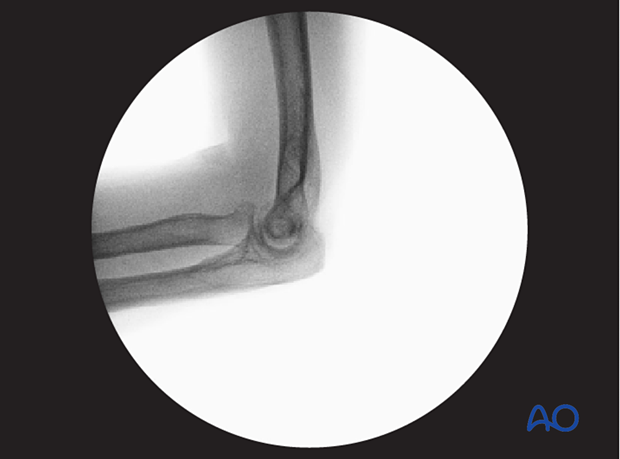
Anatomical lines and landmarks
The following lines and landmarks are seen:
- Joint line of radial head
- Joint line of coronoid process
- Proximal ulnar dorsal angle (PUDA)
- The anterior cortex of humerus bisects the circular projection of the trochlea
- The axis of the proximal radial shaft is aligned with the center of the capitellum
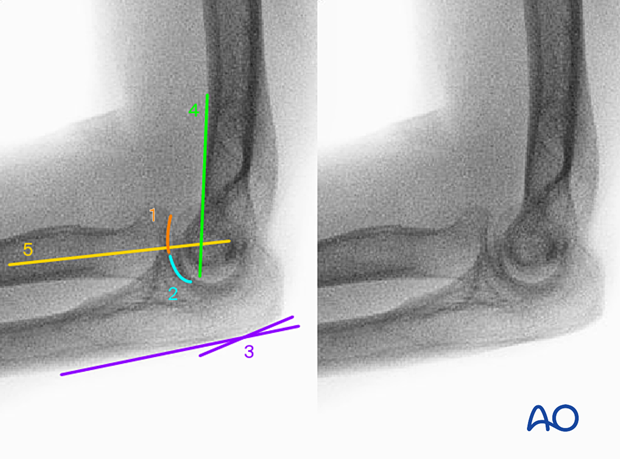
What can be observed
This view is particularly useful to identify:
- fracture reduction with correct alignment of PUDA and radial shaft alignment with capitellum
- joint incongruency (step off, gap, subluxation)
- implant positioning on the radial head and proximal ulna
4. Oblique view of the proximal ulna
- Shoulder in 90° abduction and 20-30° extension (the beam needs to be 60-70° to the axis of the humerus)
- The humerus is rotated internally 30°
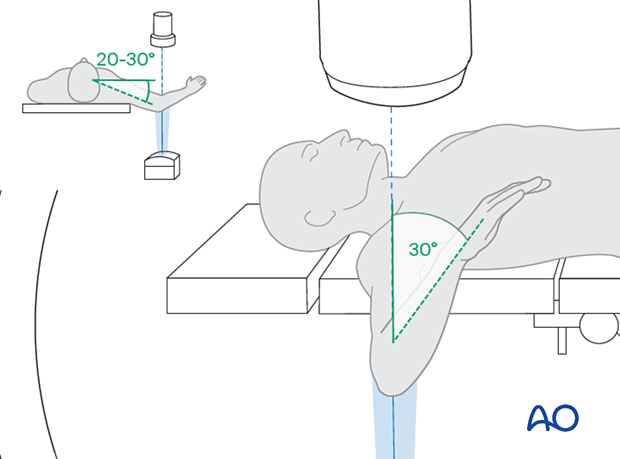
- The elbow is flexed 30-45°
- The forearm is in neutral rotation
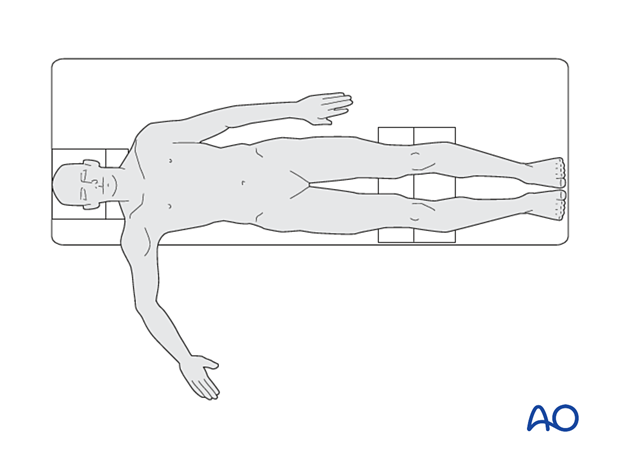
Verification of optimal view
The radial head is superimposed on the proximal ulna and has to project posteriorly to assess the coronoid process.
The humerus is rotated internally until the olecranon, the tip of the coronoid and the anteromedial facet of the coronoid are visible.
Overlap of distal humerus with the tip of the coronoid can be avoided by bringing the elbow into extension.
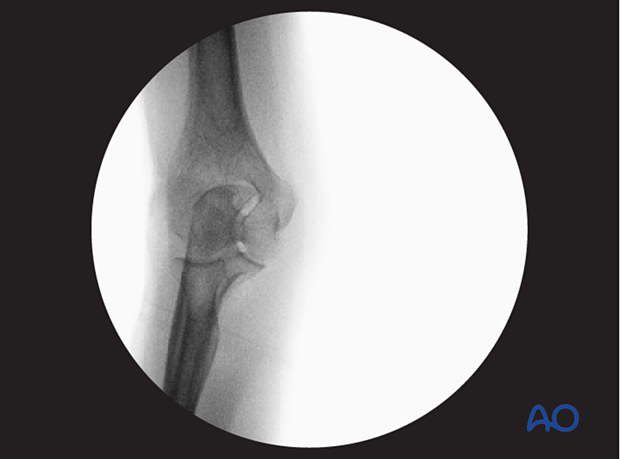
Anatomical landmarks and lines
The following lines and landmarks can be observed:
- Medial edge of greater sigmoid notch with the tip of olecranon
- Coronoid tip
- Anteromedial facet of the coronoid process
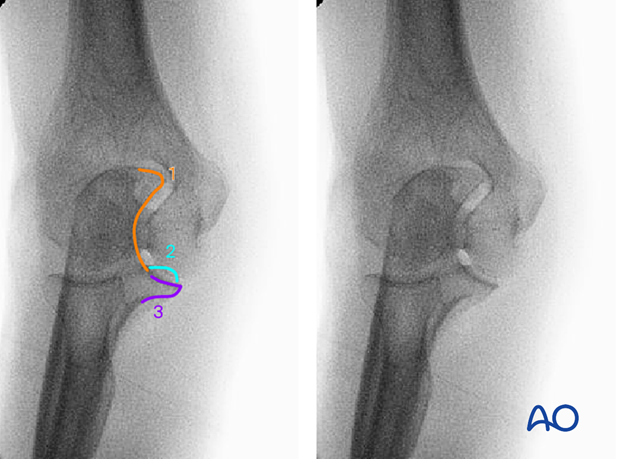
What can be observed
This view is particularly useful to identify:
- fractures and malalignment of coronoid tip or antero-medial facet
- penetration of screws into the ulnohumeral joint space
- implant malposition
5. Axial view of the proximal forearm
Positioning for optimal view
- Shoulder in 90° abduction and neutral rotation
- The elbow is flexed as much as possible
- The forearm is in neutral position
- The beam is placed perpendicular to the humerus (and in the plane created by the humerus and the forearm)
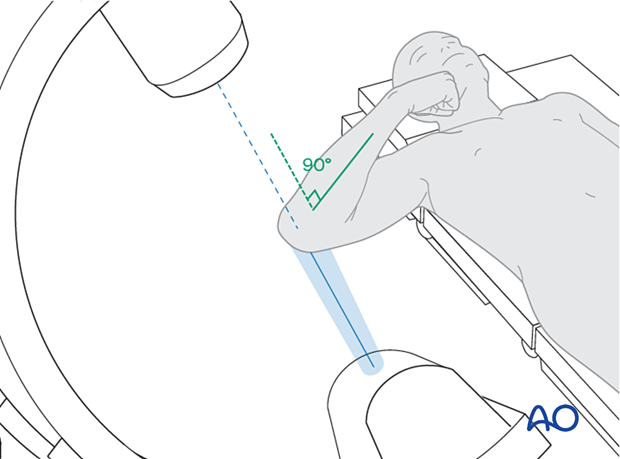
Verification of optimal view
The optimal view is obtained when the:
- elbow is completely flexed
- olecranon tip is centered and congruent with the distal humeral joint line
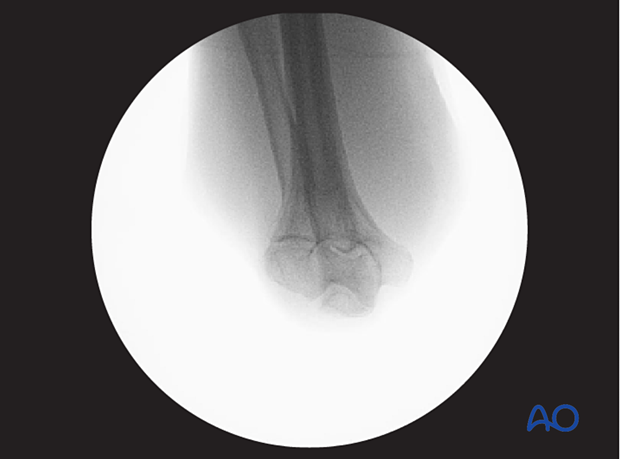
Anatomical landmarks and lines
The following lines and landmarks can be observed:
- Posterior trochlear joint line
- Anterior trochlea joint line
- Radial head joint line
- Coronoid process joint line
- Olecranon tip
- Capitellum
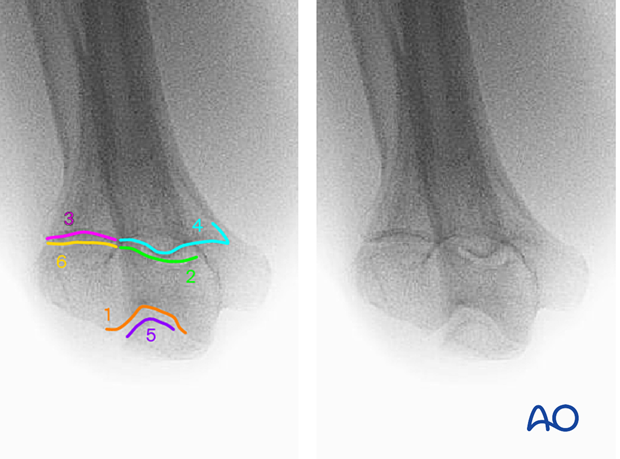
What can be observed
This view is particularly useful to identify:
- Screw penetration into the ulnohumeral joint
- Joint incongruency
- Intraarticular fracture malreduction
6. AP view of proximal radio-ulnar joint (PRUJ)
Positioning for optimal view
- Shoulder in 90° abduction and 20-30° external rotation
- The elbow is in full extension
- The forearm is in full supination
- The beam is placed perpendicular to the forearm (but 20-30° to the plane created by the humerus and the forearm)
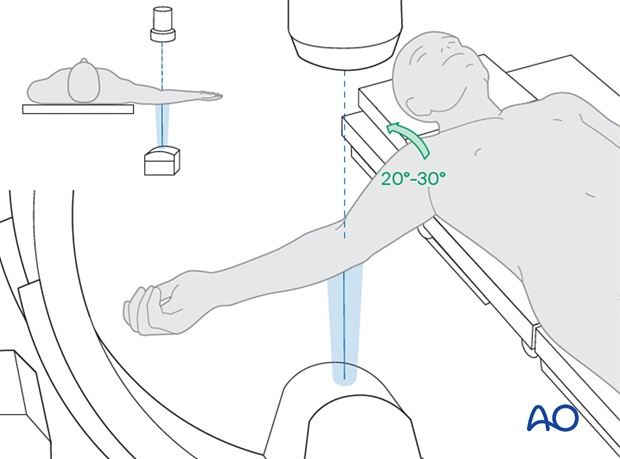
In case the elbow cannot be fully extended (eg 20° flexion) the AP view can be compensated by extending the shoulder as illustrated (eg 20°).
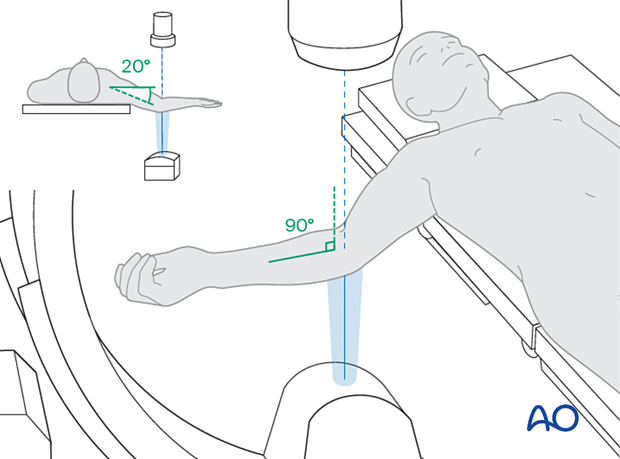
Verification of optimal view
The optimal view is obtained when the:
- Anterior and posterior edge of sigmoid notch form one line
- Supinator crest is visible
- Radial tuberosity is visible
- Curvilinear shape from PRUJ to radial tuberosity
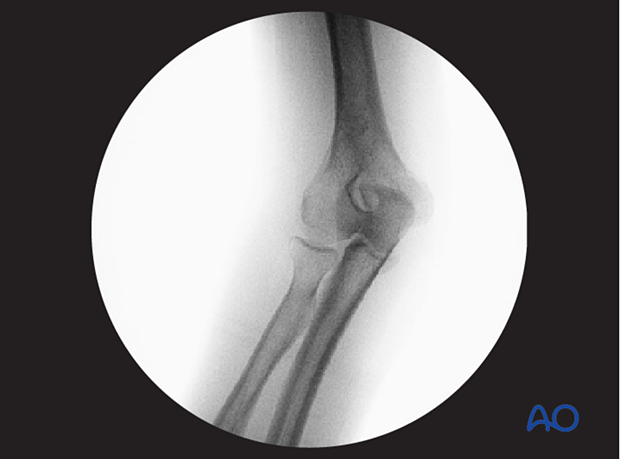
Anatomical lines and landmarks
The following lines and landmarks can be observed:
- Joint line of radial head at the proximal radioulnar joint (PRUJ)
- Joint line of sigmoid notch of ulna at PRUJ
- Supinator crest of the ulna
- Radial tuberosity
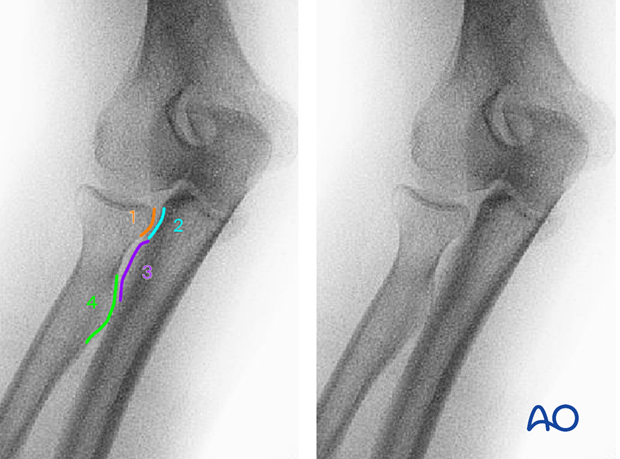
What can be observed
This view is particularly useful to identify:
- fractures and malalignment of the radial head (check from supination to pronation) and PRUJ
- Implant malpositioning on the radial head and proximal ulna (with respect to PRUJ)












